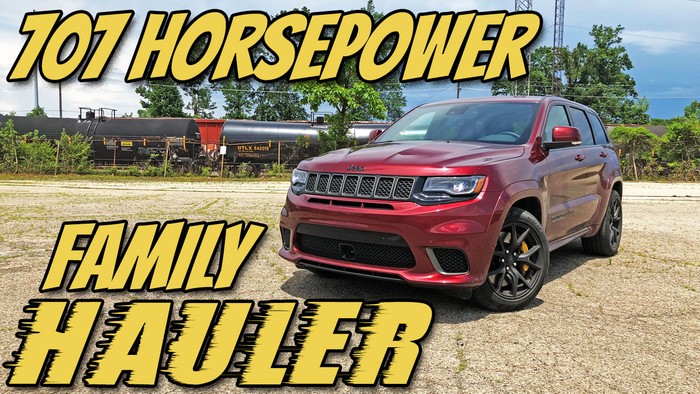
Video review: Jeep Grand Cherokee TrackHawk
We try out Jeep's 707 horsepower family hauler.
Two years ago FCA's quest to Hellcat-All-The-Things spilled over to the company's Jeep brand, resulting in the 707 horsepower Grand Cherokee TrackHawk. But since then, several other high-performance SUVs have joined the fray, including the wildest of the bunch, the Lamborghini Urus. Curious to see if the TrackHawk still holds up in a brave new world where Lamborghini makes an SUV, we decided to order one up for a week-long evaluation.
What is it?
By now the TrackHawk shouldn't need much of an introduction, but let's cover the basics just so we're all on the same page. The TrackHawk is the highest performing version of the Grand Cherokee, slotting ahead of the SRT model that has been around since the last-generation of the mid-size SUV. The TrackHawk actually has a smaller V8 than the SRT -- 6.2L versus 6.4L -- but the TrackHawk benefits from a massive supercharger, netting power ratings of 707 horsepower and 645 lb-ft of torque. Even in a post-Urus world, no SUV offers more horsepower than the TrackHawk.
Although other vehicles with the Hellcat engine are available with a manual transmission, the TrackHawk can only be had with an eight-speed auto. However, the TrackHawk has one key advantage over FCA's other Hellcat products -- all-wheel drive. The TrackHawk is a Jeep, after all.
Being a high-performance vehicle, the TrackHawk has all the requisite hardware -- a stiffer suspension, bigger wheels and tires and massive Brembo brakes to keep its 707 horsepower in check. There's even a launch button and a 200mph speedometer, which are hilarious to see in a family SUV.
But the TrackHawk isn't all about performance. With a base price of $86,000 (yes, you read that right), the TrackHawk also must include the kind of luxury people expect from a high-end vehicle. To that end the TrackHawk features a leather-covered dash, carbon fiber accents, heated and cooled seats and a configurable gauge cluster.
Exterior styling is somewhat restrained for a vehicle packing more than 707 horsepower. In fact, most of the TrackHawk's exterior design cues are borrowed from the lesser SRT. But there are a few ways to identify a TrackHawk -- TrackHawk models don't have fog lights (they were removed to improve airflow to the engine) and there's also an extra grille slot on the front. Badging is equally subtle, with just a couple of 'Supercharged' badges on the front doors and a TackHawk logo on the tailgate.
What's it like to drive?
At lower speeds, the TrackHawk drives remarkably like a normal Grand Cherokee. Despite having 707 horsepower under hood, the TrackHawk doesn't feel like a rabid dog that's always pulling on its leash; its throttle isn't a hair trigger so the TrackHawk is perfectly capable of cruising around at legal speeds like a normal car.
But whenever you want, you can stomp the gas pedal and summon a car that is anything but normal. The TrackHawk is quick off the line (Jeep says the sprint to 60 flashes by in 3.5 seconds) but it feels even faster when accelerating from speed. Passing maneuvers are dispatched in a way that temporarily rearranges your face. And the speed doesn't stop. The TrackHawk's acceleration keeps coming fast and hard, even as the needle sweeps past the half-way point of its 200mph speedometer.
As you'd expect from a performance vehicle, the TrackHawk rides on a firm suspension. Although not as cushy as a typical family SUV's ride, we never found the TrackHawk to be overly harsh. And the trade-off for comfort is well worth it when the TrackHawk finds a corner. Naturally a vehicle as big and tall as the TrackHawk is never going to be a sports car, but it is legitimately fun to hustle down a backroad. It also helps to know you have massive Brembo brakes and an all-wheel drive system should you get a little too rambunctious with the TrackHawk's 707 horsepower.
Perhaps just as intoxicating as the TrackHawk's speed is the noise it makes. The exhaust note is actually a bit restrained for a vehicle with a Hellcat engine, but you do get a nice bark when the TrackHawk fires to life. But the best noise the TrackHawk makes its easily it supercharger whine, which is totally over-the-top.
Leftlane's bottom line
The Jeep Grand Cherokee TrackHawk isn't as fast or as wildly styled as the Lamborghini Urus, but none of that matters. The TrackHawk is just perfect the way it is.
The TrackHawk is fast, immensely practical and, although expensive for a Jeep, reasonably priced for a supercar. The TrackHawk is a true do-it-all that doesn't have to make any apologies.